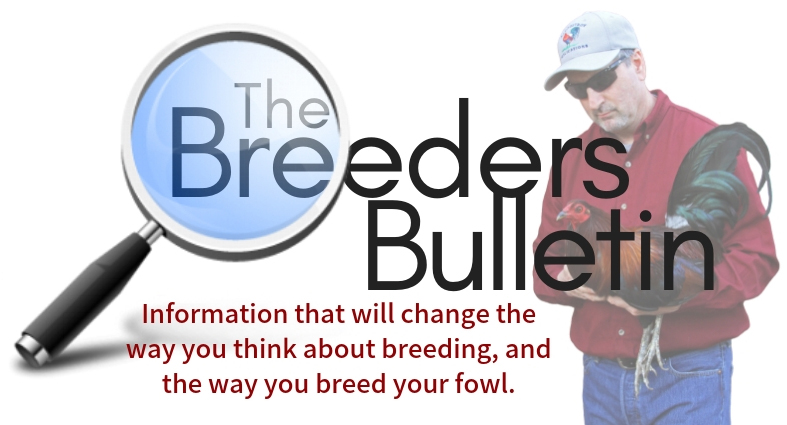COLLECTING AND STORING EGGS: If you find it necessary to hold onto eggs until you have a good broody hen, or you are waiting for available space in your incubator, here are some guidelines to follow when storing eggs.
Mother Nature is amazing. The reason we’re able to store eggs for hatching is because nature allows for a period of dormancy. This enables the hen to collect a sizable clutch of eggs before deciding to set. This period of dormancy allows all the chicks to hatch at the same time. Otherwise, some chicks would die of starvation because they hatched too early or would be left behind because they hatched too late.
The first thing you’ll want to do is make sure that the eggs you are collecting come from good healthy, vigorous brood fowl. The health and vigor of the parents have a huge effect on the health and vigor of their offspring.
Many are shocked when I tell them that I never breed to sick chickens, or chickens that were sick in the past. This susceptibility to disease is a genetic weakness that can be passed to their offspring. As a result, I always select to improve disease resistance. In other words, I always select the healthiest, and most vigorous brood fowl, and cull any and all fowl that show symptoms of disease.
Next, select eggs that are of the right size, shape and quality. Any eggs that are too small or overly large should be tossed or eaten. Any eggs that are oddly shaped are tossed or eaten as well. Seldom do these eggs hatch anyways.
Small eggs, such as those produced by pullets, tend to produce small offspring. So, don’t hatch small eggs unless you deliberately want to decrease the size of your strain. I also like to examine the quality of the shell, and look for cracks, pin holes or rough spots. The shells should be thick and smooth. Eggs with wrinkles of any kind should also be tossed.
Next, make sure to store the hatching eggs with the pointy end of the egg in the down position. Place the eggs where it’s dark, cool, and draft free. A temperature of 45 to 55 degrees will keep the embryos in a dormant condition. You should never store eggs in the refrigerator, or try to keep them warm. The embryo will die at temperatures less than 40 degrees and may begin to spoil at temperatures that are above 60 degrees. Also, the moisture in the refrigerator affects the protective cover of the egg, which is produced by the hen during the laying process.
Make sure not to clean the eggs. This opens the pores of the eggs shell and cause bacterial contamination during incubation.
Storing eggs longer than 7 days can have a huge effect on hatchability. For instance, eggs that are more than a week old usually have a lower hatch rate. I have hatched eggs that were between 14 and 21 days old with some success. But I get my best results with eggs that are less than 7 days old.
After a few days of storage, the eggs will need to be turned twice a day. If not turned, the yolks tend to stick to the inside lining of the eggshell, again lowering the rate of hatchability. I like to place the eggs in an egg carton and lean the eggs at a 45-degree angle. A simple brick or 4”x4” block of wood works great. I will rotate the entire carton of eggs in the morning, and again when it gets dark.
PREDETERMINING THE SEX: Despite what some people think, it is not possible to predetermine the sex of a chick by the shape of the egg. I had a person come to me once to buy hatching eggs, but he only wanted stag eggs. When I asked him, with quite a bit of skepticism, “how he could tell,” he said “the pointy eggs are always stags and the round eggs are always pullets.” Although I firmly disagreed with him, I could see that nothing I had to say was going to change his mind. So, I let him pick out the pointy ones and sent him on his way. I hope he got what he was looking for, but I doubt it.
If it was possible to sex eggs by the shape of the egg, the commercial hatchery industry would have done this long ago, believe me! Think of the time and money they would have saved by hatching only pullets. There would be more space in the incubators, no sexing chicks, no disposing of surplus cockerels. But as it stands, at this time, this is not a reliable practice.
The shape of a hen’s egg is determined by her genes. The shape of the egg is unique to each and every hen. It is like our fingerprints. If a hen lays a certain shaped egg, she will most likely always lay eggs of that shape. What I find interesting, is that this is a heritable trait. Which means, we can improve the quality and shape of our eggs by selecting hens that lay high-quality eggs that are of the proper shape.
The most common variable with concerns of the egg is the size. As she gets older, her eggs will get larger. This is another reason that I don’t recommend breeding to hens that are older than 6 years.
There are times, however, when a hen will lay an oddly shaped, or misshapen egg. This is due to an abnormality or environmental condition. Those eggs should be tossed, not incubated.
The best method we have for sexing baby chicks is by comparing each chick’s wing feathers at hatching time. Pullets tend to have longer wing feathers, while stags have shorter wing feathers. Very few hatcheries’ use vent sexers these days. It has become a dying art.
MARKING THE EGGS: When I collect eggs for hatching, I mark each egg to record all the information I will need to keep track of their lines, and ensure their pedigrees. This includes:
- Date the egg was laid. This enables me to keep track of how long the eggs has been stored.
- Brood pen number. When setting up my brood pens, and pairing up my breeders, I record the wing and leg band numbers of each bird, and their respective brood pens. This enables me to compare the information on each egg to the corresponding brood pens. This is good for keeping pedigrees, and analyzing results of fertility and hatchability.
- The breed. This enables me to categorize the eggs by the breed (in the cartons and in the incubator).
- And family line. This enables me to separate the eggs and chicks into their respective strains/families.
For marking eggs, I have used a number of markers, such as pencils, pens, sharpies and crayons, they all work great. Just make sure they are easy to read, and that it won’t rub off during the normal course of hatching. Also, make sure you don’t puncture the shell.
Special note of interest: Some advice not to use fluid markers. They believe there’s a chance the fluid may soak through the shell and possibly affect the developing embryo. I’ve used sharpies for many years, and I personally have not experienced an issue with this method.

